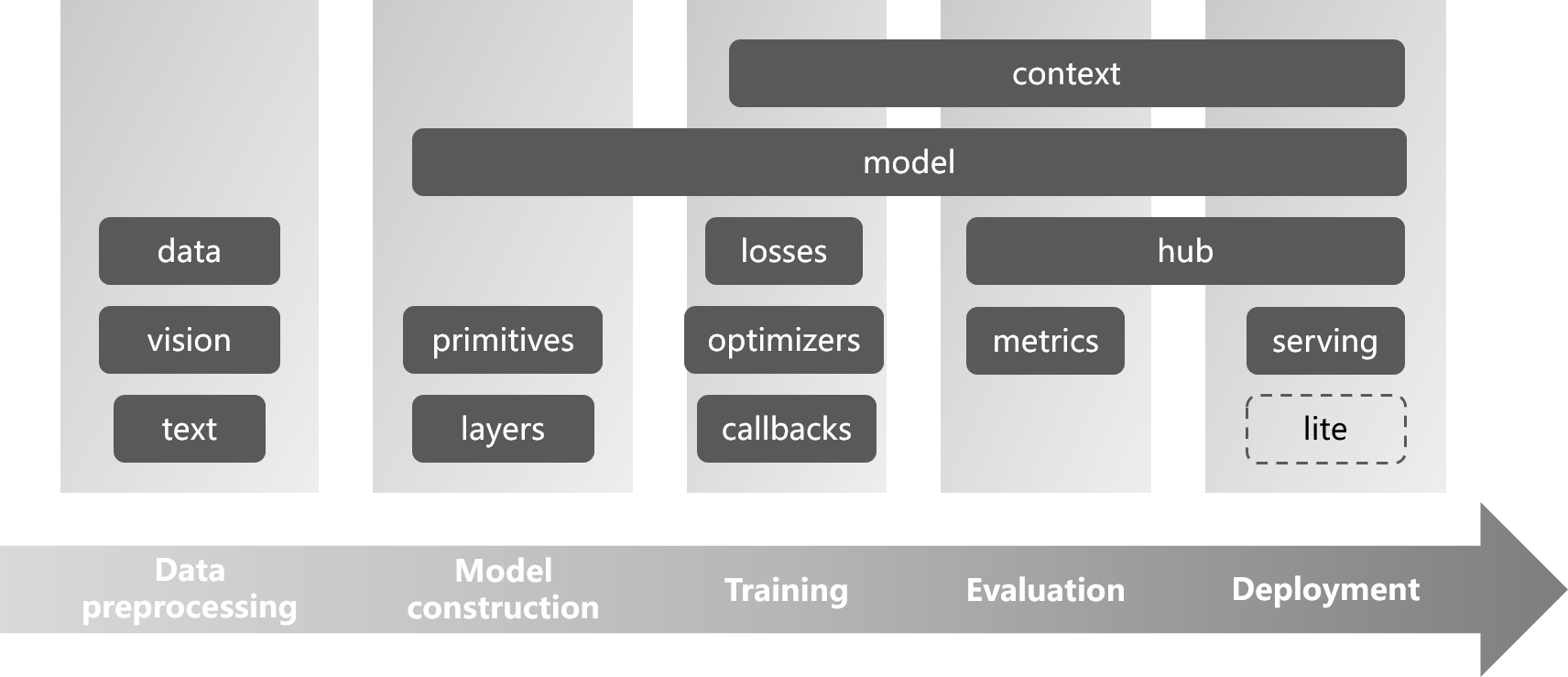English | 查看中文
TinyMS is an Easy-to-Use deep learning framework development toolkit based on MindSpore, designed to provide quick-start guidelines for machine learning beginners.
| Distribution | Version | Command |
|---|---|---|
| PyPI | x.y.z | pip install tinyms==x.y.z |
| latest | pip install git+https://github.com/tinyms-ai/tinyms.git |
|
| Docker | x.y.z | docker pull tinyms==x.y.z |
| latest | - |
NOTICE: The
x.y.zversion shown above should be replaced with the real version number.
Please checkout the install document to quickly install or upgrade TinyMS project.
Have no idea what to do with TinyMS❓ See the Quick Start to implement the image classification application in one minutes❗
Besides, here are some use cases listed to demonstrate how TinyMS simplifies the code flow for users.
from tinyms.data import MnistDataset, download_dataset
from tinyms.vision import mnist_transform
data_path = download_dataset('mnist')
mnist_ds = MnistDataset(data_path, shuffle=True)
mnist_ds = mnist_transform.apply_ds(mnist_ds) |
from tinyms.model import lenet5
net = lenet5(class_num=10) |
from tinyms.model import Model
model = Model(net)
model.compile(loss_fn=net_loss, optimizer=net_opt, metrics=net_metrics)
model.train(epoch_size, train_dataset)
model.save_checkpoint('./checkpoint_lenet.ckpt')
···
model.load_checkpoint('./checkpoint_lenet.ckpt')
model.eval(eval_dataset) |
from PIL import Image
import tinyms as ts
from tinyms.model import Model, lenet5
from tinyms.vision import mnist_transform
img = Image.open(img_path)
img = mnist_transform(img)
net = lenet5(class_num=10)
model = Model(net)
model.load_checkpoint('./checkpoint_lenet.ckpt')
input = ts.expand_dims(ts.array(img), 0)
res = model.predict(input).asnumpy()
print("The label is:", mnist_transform.postprocess(res)) |
If you are interested in learning TinyMS API, please find TinyMS Python API in API Documentation.
For a more detailed step-by-step video tutorial, please refer to the following website.
| Episode | Title | Content | Docs | Status | Update Time |
|---|---|---|---|---|---|
| EP01 | How to learn Deep Learning? The Most Efficient Way For Beginners! | Teacher's profile+DeepLearning Course Introduction | - | Published | 2021.3.30 |
| EP02 | How we teach computers to understand pictures? Three Ways to Install TinyMS | It uncovers the magic of computer vision + three ways to install TinyMS (Ubuntu, Win10, Docker) | TinyMS Installation For Beginners | Published | 2020.3.31 |
| EP03 | Learn Shell Script in 30 Minutes | It covers the essential concepts such as using variables, basic operators, loops & functions and so on. It also gives you an insight by scaling down some real-time scenarios and demonstrating them using the docker container. | Learn Shell Script in 30 Minutes (doc) | Published | 2020.4.1 |
| EP04 | Learn Python in 30 Minutes(Part I.) | Python installation, basic syntax, primitive data types and operators | Learn Python in 30 Minutes | Published | 2021.4.23 |
| EP05 | Learn Python in 30 Minutes(Part II.) | Python conditional statements, loop statements, iterators, generators, functions, class, module, advanced usages, and several most commonly used Python libraries in deep learning | Learn Python in 30 Minutes | Published | 2022.1.10 |
For any developers who are not familiar with how TinyMS community works, please find the Contributing Guidelines to get started.
The release notes, see our RELEASE.







